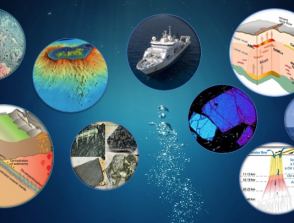Volcano tectonic interactions in the Comoros archipelago
03/04/2024
IPGP - Campus Jussieu
14:00
Soutenances de thèses
Amphithéatre
Pierre Boymond
Géosciences marines (LGM)
The Comoros archipelago lies to the north of the Mozambique Channel, between Madagascar and East Africa. It comprises four volcanic islands (Grande Comore, Mohéli, Anjouan and Mayotte from west to east), as well as submerged volcanic features such as the Zélée-Geyser bank, the Vailheu seamount and the Jumelles, Domoni, Chistwani, Safari and Mayotte Est volcanic chains. In this thesis work, we seek to understand the origin of volcano-tectonic activity in the Comoros by combining marine geophysical studies and numerical modeling.
Based on high resolution geophysical data acquired in 2021 during the SISMAORE marine cruise (bathymetry, acoustic backscatter, 48-channel reflection seismic and sub-bottom profiler data), we identified and mapped faults, dykes, sills, cones, lava flows that compose two main volcanic fields (Mwezi and N’Drounde). We analysed their organisation in map view and in cross-sections in the seismic data. Based on chronological information from coring data, we estimated the ages of the main seismic reflectors and proposed a spatio-temporal evolution of the volcanic fields.
Secondly, we tried to reproduce the pattern and organization of the volcano-tectonic structures with numerical models. We used the discrete element modeling approach. The lithosphere is represented by a 360x360x55 km brittle layer composed of 500,000 discrete elements (DEs) interconnected by elastic-fragile bonds resting on a fluid, inviscid asthenosphere. The model's boundary conditions are chosen to reproduce the geodynamic conditions of the North Mozambique Channel region. We were able to observe the development of an E-W trending en echelon system. The echelons have a mean direction of N145°E and have developed from their centers to the northwest and southeast simultaneously. More precisely, they are made up of N155°E and N125°E transtensional segments in which the extensive component of movement is dominant. The geometry of each echelon is compatible with a local extension oriented N45°E.
We showed that the numerical models reproduce the overall geometry of the volcano-tectonic structures we studied. The N155°E and N125°E orientations of the modeled segments correspond to the orientations of the main volcanic chains and volcanic fields of the archipelago. We have shown that the propagation of volcano-tectonic structures is consistent with that observed in numerical models. Finally, the direction of extension modelled is consistent with that inferred from the organization of volcano-tectonic structures. These similarities between numerical model results and geophysical observations suggest that the structures observed in the Comoros archipelago are consistent with those that would be observed in an immature brittle transfer zone between the between the East African Rift System (EARS) and the graben in Madagascar.





